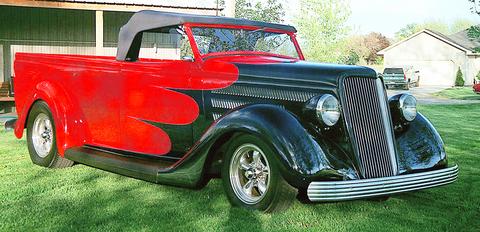The "ute" is to Australians what the pickup is to Americans: a blue-collar icon and a symbol of rugged independence. Utes are integral to everyday existence in the bush -- and, increasingly, to life in the city.
What's a ute? A utility vehicle, though the term has a different connotation down under. Simply put, it is a pickup based on a sedan -- a car with a cargo bed.

PHOTO: NY TIMES
There have been utes in the US, too, though they were seldom called that. The Ford Ranchero made its debut as a 1957 model and Chevrolet introduced its El Camino for 1959. Both ceased production long ago.
The Australian ute's origins date to Ford "roadster utilities" built in Geelong, Victoria, in 1930; these were essentially the same Model A roadsters with pickup beds that were sold in the US. But within a few years, American and Australian trucks headed onto different paths.
In the US, pickups grew ever larger and more distinct from cars; in Australia, the ute remained closely tied to automobile designs.
The early roadster-utes were unpleasant in a land with so much dust, so in 1934, Ford started making a "coupe utility" with a metal top and wind-up windows -- reportedly at the request of a farmer's wife.
"She wrote to Ford and said she wanted a car they could drive to church on Sunday and take animals to market on Monday," said Phil Newell of Portland, Oregon, an Australian who imports old utes and muscle cars -- think "Mad Max" -- at www.AussieCarImports.com.
Today's utes look like station wagons with the tops cut off behind the front seats. Every year, Australians buy 70,000 utes and small pickups, about 9 percent of the vehicle market. The Ford Falcon and Holden Commodore, from General Motors, each have about a quarter of the market, with Japanese imports accounting for the other 50 percent.
Utes can be muscle cars, with the Holden SS facing off against the Ford XR8 Pursuit Ute. Both have V8s rated at about 300hp and five-speed manual transmissions. Ute collectors who want something more rare than a Ranchero or El Camino sometimes buy them in Australia and ship them across the Pacific. The Reverand David Stands, of Kennewick, Washington, got his when he served as minister for a Church of Christ congregation in Perth for three years in the early 1990s.
A lifelong hot-rodder, Stands, 44, grew up near Bakersfield, Califoernia, where "we could see the dragstrip from the roof of our house."
In Australia, he sought out one of the early roadster-utes.
He paid US$350 for a battered example, a 1935 Ford, he found sitting beside a house in Perth. He bought another 1935 model and shipped the two to the US together. Of the six survivors from that year, he owns two; the others are unrestored.
Stands spent six years restoring the ute from Perth. He sold the second one, which is now being restored to its original condition in Florida.
"I did all the sheet metal and paint," he said of the blue and red beauty.
"And the fenders were pretty far gone -- although the Australians would say, `Oy, mate, that's mint!'"
He didn't like the proportions, so he "chopped" the windshield two inches and squared off the cowl behind the seat, flattening the original arc. He also moved the back of the cab forward and shortened the box. He devised a rumble seat for his children that folds flush into the front of the bed when not in use.
What's his custom ute worth? "When I finished it," he said, "somebody offered me US$75,000, which is a `slap me silly and pick me up off the ground' price. But it's not for sale."

Six Taiwanese companies, including contract chipmaker Taiwan Semiconductor Manufacturing Co. (TSMC), made the 2025 Fortune Global 500 list of the world’s largest firms by revenue. In a report published by New York-based Fortune magazine on Tuesday, Hon Hai Precision Industry Co. (better known as Foxconn) ranked highest among Taiwanese firms, placing 28th with revenue of US$213.69 billion. Up 60 spots from last year, TSMC rose 60 places to reach No. 126 with US$90.16 billion in revenue, followed by Quanta Computer Inc. at 348th, Pegatron Corp. at 461st, CPC Corp., Taiwan at 494th and Wistron Corp. at 496th. According to Fortune, the world’s

NEW PRODUCTS: MediaTek plans to roll out new products this quarter, including a flagship mobile phone chip and a GB10 chip that it is codeveloping with Nvidia Corp MediaTek Inc (聯發科) yesterday projected that revenue this quarter would dip by 7 to 13 percent to between NT$130.1 billion and NT$140 billion (US$4.38 billion and US$4.71 billion), compared with NT$150.37 billion last quarter, which it attributed to subdued front-loading demand and unfavorable foreign exchange rates. The Hsinchu-based chip designer said that the forecast factored in the negative effects of an estimated 6 percent appreciation of the New Taiwan dollar against the greenback. “As some demand has been pulled into the first half of the year and resulted in a different quarterly pattern, we expect the third quarter revenue to decline sequentially,”

WEAKER ACTIVITY: The sharpest deterioration was seen in the electronics and optical components sector, with the production index falling 13.2 points to 44.5 Taiwan’s manufacturing sector last month contracted for a second consecutive month, with the purchasing managers’ index (PMI) slipping to 48, reflecting ongoing caution over trade uncertainties, the Chung-Hua Institution for Economic Research (CIER, 中華經濟研究院) said yesterday. The decline reflects growing caution among companies amid uncertainty surrounding US tariffs, semiconductor duties and automotive import levies, and it is also likely linked to fading front-loading activity, CIER president Lien Hsien-ming (連賢明) said. “Some clients have started shifting orders to Southeast Asian countries where tariff regimes are already clear,” Lien told a news conference. Firms across the supply chain are also lowering stock levels to mitigate

DIVERSIFYING: Taiwanese investors are reassessing their preference for US dollar assets and moving toward Europe amid a global shift away from the greenback Taiwanese investors are reassessing their long-held preference for US-dollar assets, shifting their bets to Europe in the latest move by global investors away from the greenback. Taiwanese funds holding European assets have seen an influx of investments recently, pushing their combined value to NT$13.7 billion (US$461 million) as of the end of last month, the highest since 2019, according to data compiled by Bloomberg. Over the first half of this year, Taiwanese investors have also poured NT$14.1 billion into Europe-focused funds based overseas, bringing total assets up to NT$134.8 billion, according to data from the Securities Investment Trust and Consulting Association (SITCA),